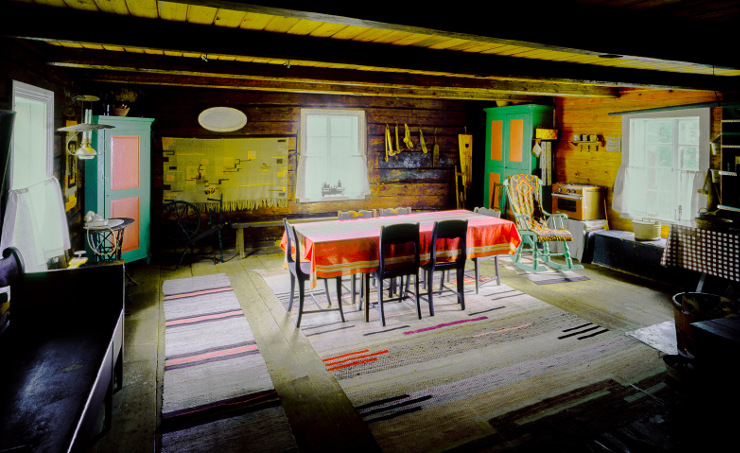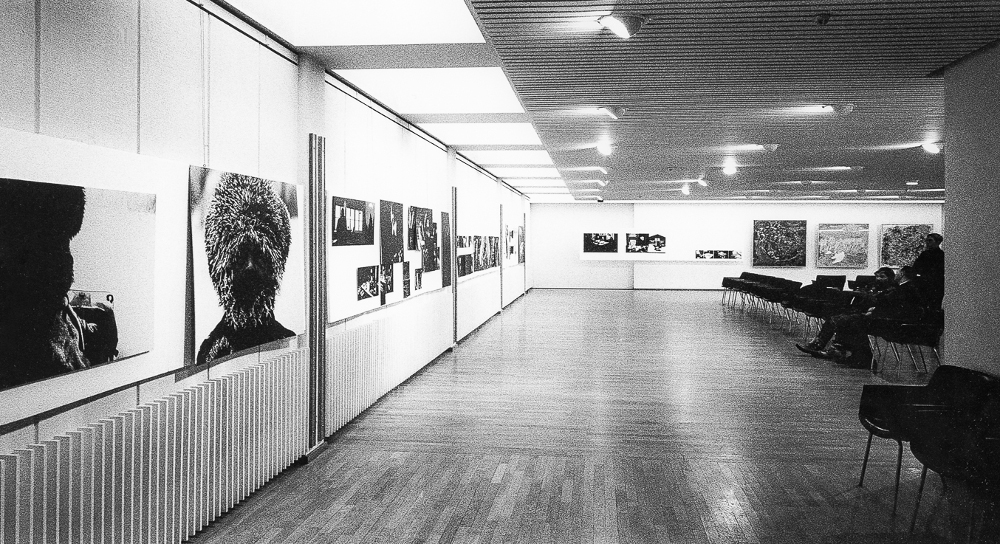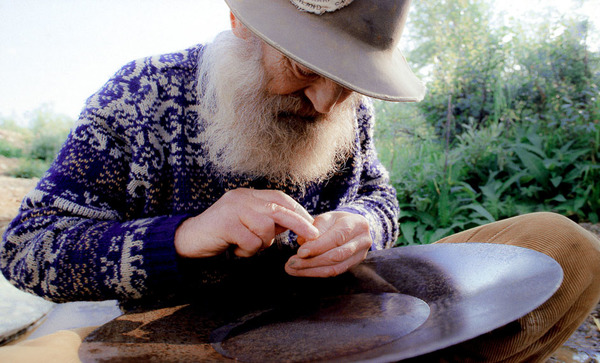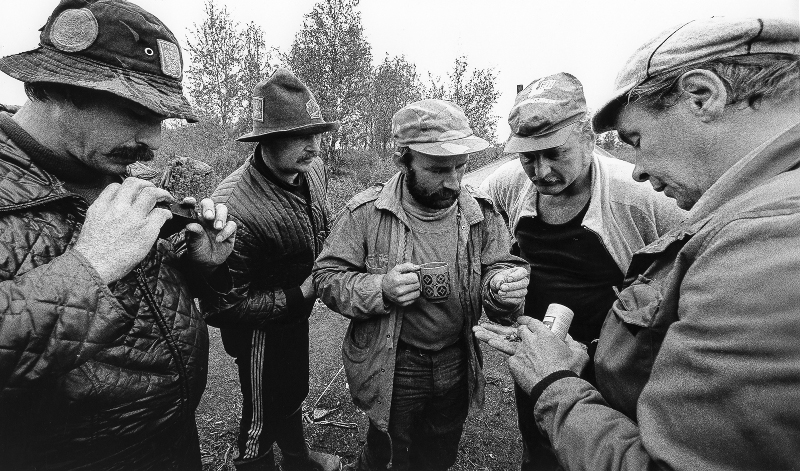

Several own exhibitions in Finland, Sweden, Estonia and Sovjet Union, in 1967-2019.
Kerron valokuvin Lapin kaikkien aikojen tunnetuimman kuvataiteilijan Reidar Särestöniemen värikkäästä elämästä ja työskentelystä kotitalossaan Ounasjokivarressa tiettömän taipaleen takaisessa Särestän Wikäfwässä, Lapin ja Lannan rajalla.

Motto: Kuu nousee alkumerestä, Heliotrooppinen hetteestä.
Olen tuonut näytteille myös Reidarin omakuvan, Heliotrooppisen. Sen hän maalasi kiitokseksi pitämästäni Reidar-näyttelystä Rovaniemellä 1969. Poikkeuksellinen signeeraus kertoo, että se on tehty 16.1.1969, siis puoli vuosisataa sitten.
It is my pleasure to tell you with photographs about the colorful life of Reidar Särestöniemi (1925-1981) who is the most well-known and successful painter of Lapland. His way of working in his parents' roadless house Särestä Wikäfwä by Ounasjoki, literally on the border of Lapland and Lanta, was unique.
I have also taken on display Reidar's self-portrait, the long rumored Heliotropic. As I was warned by the experts, not everyone can stand that such an important landmark work which now reached the direct TV news has been unnoticed by them. This picture oil on canvas is unique in many ways. Its colors are characteristic of Reidar, Mother Alma's joyful and quick little boy moving from one gag to another. The sun, Helios, is shining out of the painting's head, the right light side, shering energy on Särestö. In the background there are the Arctic area, Finnmark and Vesisaare where Reidar's most important person and protector Mother-Alma comes from.
The signature is exceptional, too. As far as I know it is one of a kind: Heliotropic 16.1.69. So this outstanding work is half a century old. Reidar finished it by way of thanks for our successful joint exhibition in Rovaniemi.
Around ten of the exhibition's pictures are of Silver Series. I have originally enlarged them for the Rovaniemi exhibition 1969. The black-and-whites have not become yellowish and the colour pictures have not faded because I have them, too, developed myself.
Kaamosajan kuvani olen ottanut Reidarin seestyneenä kautena 1967 – 1970. Se oli Särestön kulta-aikaa.
Esillä on 51 kuvaa ja kaksi kuvakollaasia. Pienimmät kuvat ovat uniikkeja hopeakuvia, jotka olen suurentanut Rovaniemen näyttelyä varten. Muut ovat 2018 parhaalla tekniikalla tekemiäni mustesuihkutulosteita koossa A2. Näitä kuvia on tarjolla sarja 1-3/3. Suurin osa kuvista on ennen näkemättömiä, eikä niitä ole tarkoitus tuoda uudelleen esille eikä saataville.
Now I am living in digital-time. I have scanned my old negatives, developed them by Photoshop or Ps Lightroom and printed them by the newest technique on the best paper (Epson - Hahnemühle).
Far-away from Helsinki in the polar night I recorded closely the Northern Picasso during the years 1967-1970. I was lucky because it happened to be Reidar's most creative period. His vision was crystallized, technique in his possession and working mood excellent. Several astonishing paintings came into being. Together we took them to the buyers like the enormous and huge Huurrekoivut (Frosty Birchs) to the Swedish Norrbotten Regiment.
"Mie en köyhile myy" (Reidar)
Näyttö alkaa keskiviikkona 9. tammikuuta 2019 kello 17. Se päättyy ainutkertaiseen Hagelstam & Co:n huutokauppaan Heliotrooppisen 50-vuotispäivänä keskiviikkona 16. tammikuuta 2019 kello 17. Myynnissä ovat niin öljyvärimaalaus kuin kaikki valokuvat.
Lapin ja Lannan raja 1600-luvulla: ...Särestä wikäfwä --- Kehlon täkä mä järfwu... (Särestö oli Lannan pohjoisin paikka)
For years Anttu gave ride to Commercial Councilors on the way to Särestö. Now the quests were Honorary Mining Councilors. Even Mr. President took a sauna and hete bath here. Money circulated. It was the Golden time of Särestö.
Reidar used to paint in the winter; with more enthusiasm the darker and colder it was. No tourists or mosquitos swarming around. There was short of light. It was a challenge for a photographer. Even now people sometimes ask me what on earth was the film I used. The answer is: Kodak Royal-X which I exposed according to ASA 10 000 and developed by my own poisons in my own laboratory. I never used artificial light or flash. My camera was Hasselblad, particularly SWC.
Heliotrooppinen ei ollut ihastunut huutokaupassa kokemastaan. Mie en köyhile myy -shamaani olisi siinä mennyt mielestään itse halvalla.
After the Hagelstam auction in January 2019 in Helsinki I have expanded the collection to 66 photos. The price is expanded too, being now 81 000 euros.
Teos on arvioitu uudelleen. Siinä on nähty Särestön kulta-ajan elämäniloinen, luomisvoimainen Alman keppostelijapoika Reidar omaperäisine, maagisine väreineen. Vastaavanlaista omakuvaa ei Ateneumin kokoelmissa ole miltään taiteilijalta. Siellä piehtaroidaan kurjuudessa ja synkkyydessä.

Ainutlaaatuinen teos on nyt sijoitettu samaan holviin Kuussa käyneen Apollo 11 -filmin kanssa. Sieltä Heliotrooppinen on muuttava uuteen kotiin sopivalla siirtosummalla.

Risto Lounema has documented the Tammio fishing village and it's old inhabitants during the summers 1991-1993. The exhibition - selenium toned 42 black-and-white photos realized by classic documentary means - has been shown eight times. This exhibition has been complemented by ten indoor pictures of the same summers. They have been shot by an architecture camera, their weight is over 200 MB and size A2 and A3+. The photographer himself has developed the pictures by Photoshop Lightroom.
The opening attracted so many visitors, almoust 150 people, that they could not come inside at the same time. This in spite of the fact that the island is remote and only three persons live there all-year. The visitors came by two vessels from Hamina and Kotka cities.
The opening ceremony took place in a sunny summer weather and was documented by four photographers.
Avajaisesite suomeksi, lataa
"The holy rändrahnud, glacial erratics, once worshipped by us are Finland´s gift to the Estonian nature."
"Mr. Risto Lounema, Master of Science, is showing that on the northern shore of the Gulf of Finland there still remain thousands of odd boulders in strange positions and places."
"The origin of big glacial erratics found in Estonia particularly on the shore of the Gulf of Finland has been a fascinating mystery. Their secret was revealed only for 150 years ago. They are pieces of the Finnish basement which have been driven here across the sea basin by the continental glacier."
"Lounema´s Glacier Erratics exhibition suits very well the Ice Age Centre in Äksi near Tartu and the UNESCO geopark founded around it."
"Nature is the inexhaustible source and inspiration of the Finnish art."
"The veteran photographer Risto Lounema has found there much more than flowers and birds. He has made the inanimate stones on the walls of the Gallery Laura to look like unbelievably colourful huge jewels."
"Lounema´s pictures show original and interesting colour world. No doubt that subjective view of the nature belongs to gallery art."
"From the very beginning of his career Risto Lounema has created his brand 'Text and Pictures by Risto Lounema'. This idea has lasted a lifetime, over 60 years, which is surprising when talking about such a dynamic field as photojournalism", says Mai Anttila, Professor emerita of Business Administration, Marketing at Aalto University, Helsinki School of Business.
Links:
Google Search: Seidat Risto Lounema
All over 60 years old people living in the summer 1991-93 in Tammio island are presented in 42 pictures.
The artist has used following equipment and"In these pictures you can still feel the life in Tammio as it was hundred years after the golden days of the island." – Taiteen maailma 3/1993.
"Lounema has taken advantage of the means of classic photography when portraying the architechturally valuable milieu of the old fishing village. The inhabitants have been photographed in their picturesque summer homes where for instance lighting gives special atmosphere." – Kymen Sanomat 2.7.1993
"Risto Lounema visited Tammio in the summer 1953 when his aunt lived in Hamina. He was impressed of the island and decided to come back with some ideas for the future. So you can almost say that the idea is now to be seen in the Gallery." – Kymen Sanomat 30.7.1993

"Lounema's works are characterized by individual style, understanding of nature and excellent knowledge of colours. Risto is known particularly as master of colour photography", says the Murmansk museum's official critics in 1973.
"Lounema's photo exhibition was a great success", newspaper Lapin Kansa's headline on 21st of April 1971.
"Photo artist Risto Lounema from Helsinki held an exhibition of reindeer keeping at the Murmansk art museum. The exhibition was a great success. It and the artist were noticed by the television several times. Also the local radio and press were much interested in Lounema's exhibition."
Lapin Kansa ends the article: "The people in Murmansk were so enthusiastic about Lounema's photos that the artist was invited to have a new exhibition in the near future."




Risto Lounema´s fifty year project has now been finished. A large colour picture exhibition of the gold rush in Lemmenjoki, a unique phenomenon in our continent and culture heritage of Finnish Lapland. The history of the river gold in Lapland dates back for 500 years.

The authentic reportage photos honour the late lifelong shovel diggers, those legendary men in the wilderness who could lead solitary life in their hermit´s cells all-year. The documentation mainly focuses on the 1980´s. The oldest pictures are 50 years old but nevertheless in colours.

There are 80 big-size pictures, mostly A3-A2. They represent ten now deceased legends, the same number of other faithful pipe workers, representatives of the original nature like pine grosbeak and wild landscapes like massive Morgam-Viipus and Ravadas-rapids also seen from the air.

Rarities of the exhibition are the return of Gold-Korhonen from the USA, Bear-Korhonen´s winter mine in Jäkälä-Äytsi, the famous purchase of wife by Kokko-Heikki with a bottle of Lemmenjoki gold nuggets and many other special events.

During the last few years Risto Lounema has studied digital photo developing by using Adobe Photoshop and Ps Lightroom. He has made by himself prints for his solo exhibitions in Helsinki 2016 and Tartu Estonia 2016 as well as for Morgam Gold – Panning in Wild Lapland and now for The Sami Villages in Finnish Lapland.



Risto Lounema has documented in Lapland by photographing and filming Finno-Ugric dying folk's life, particularly reindeer keeping on the borders of Oikoumene for a half a century since 1966. For this purpose he has even lived with his family on the north side of the Artic Circle for three years 1971-1974. During this period he has become acquainted with besides the Finnish Lapland, Norway's Finnmark and partly also the Murmansk area with their people, nature and environmental problems.
Interest in the Northern Europe is a fate inherited from the forefathers. While acting as rural police chief in Kuusamo his mother’s father recorded with his plate camera areas and life behind the Arctic Circle in demanding circumstances during the 1910's (www.lounema.fi/photography).
Risto Lounema has made of Lapland around one hundred large 4-7 pages periodical articles with some one thousand pictures; three picture books; five 25 minutes tv-documents; and numerous smaller projects.
After the Reidar Särestöniemi exhibition-auction (www.mutualart.com/Auction/Golden-Age-of-Saresto) and after completing the exhibition Morgam Gold – Panning in Wild Lapland he has worked on the exhibition of the Finno-Ugric heritage Sami Villages in Finnish Lapland. There will be 120 big-size photographs in B/W and colour not seen before. And the price is 131 000 €.